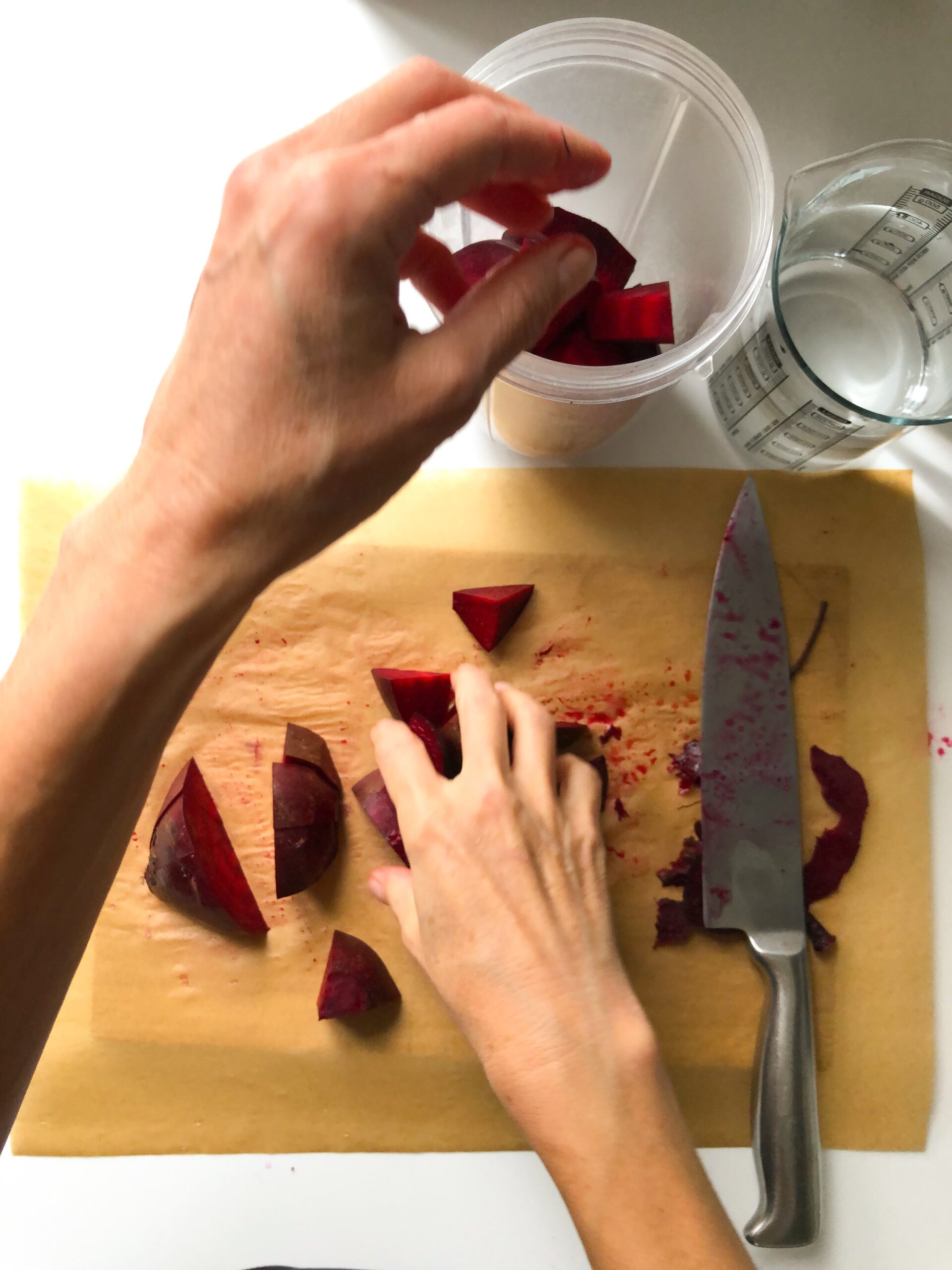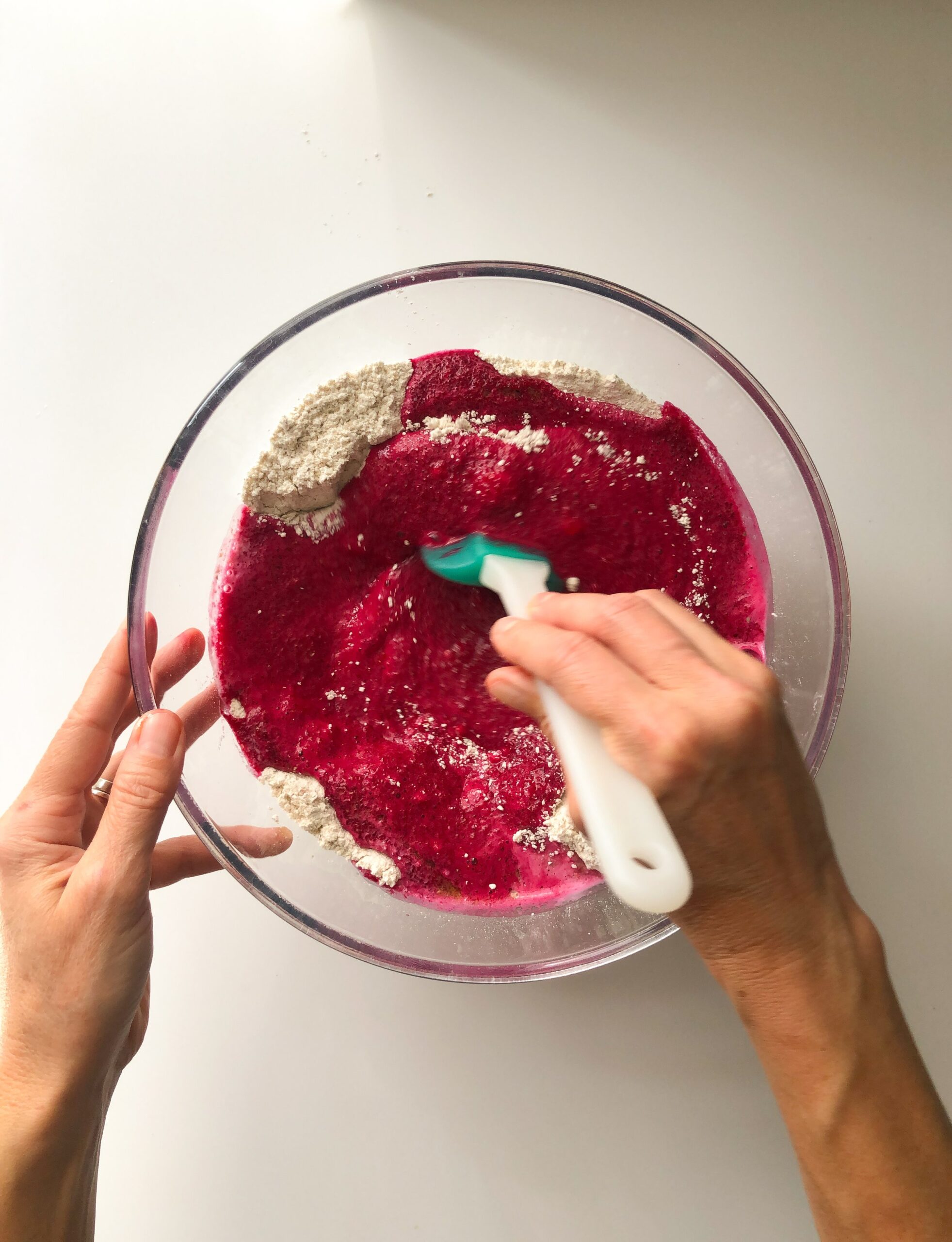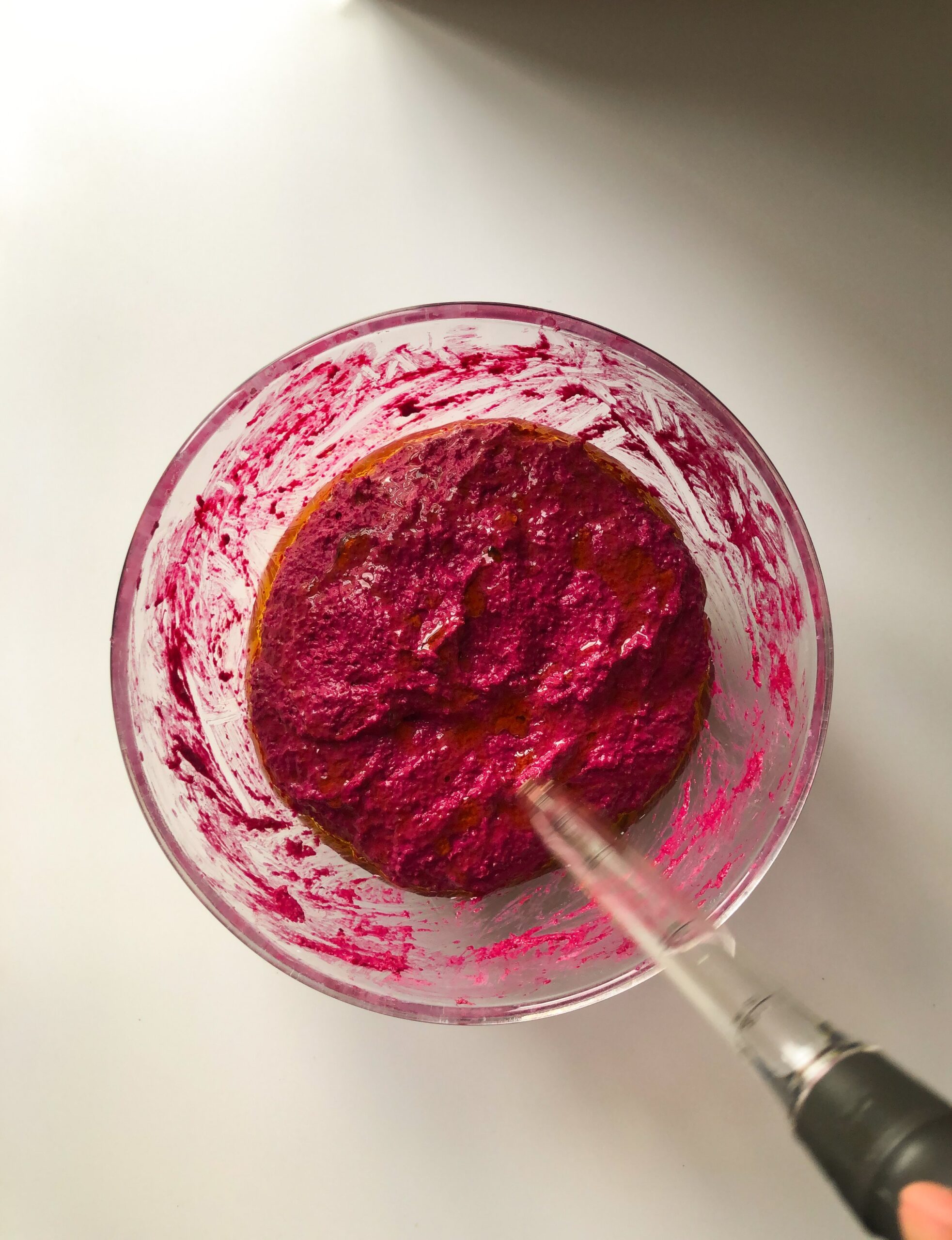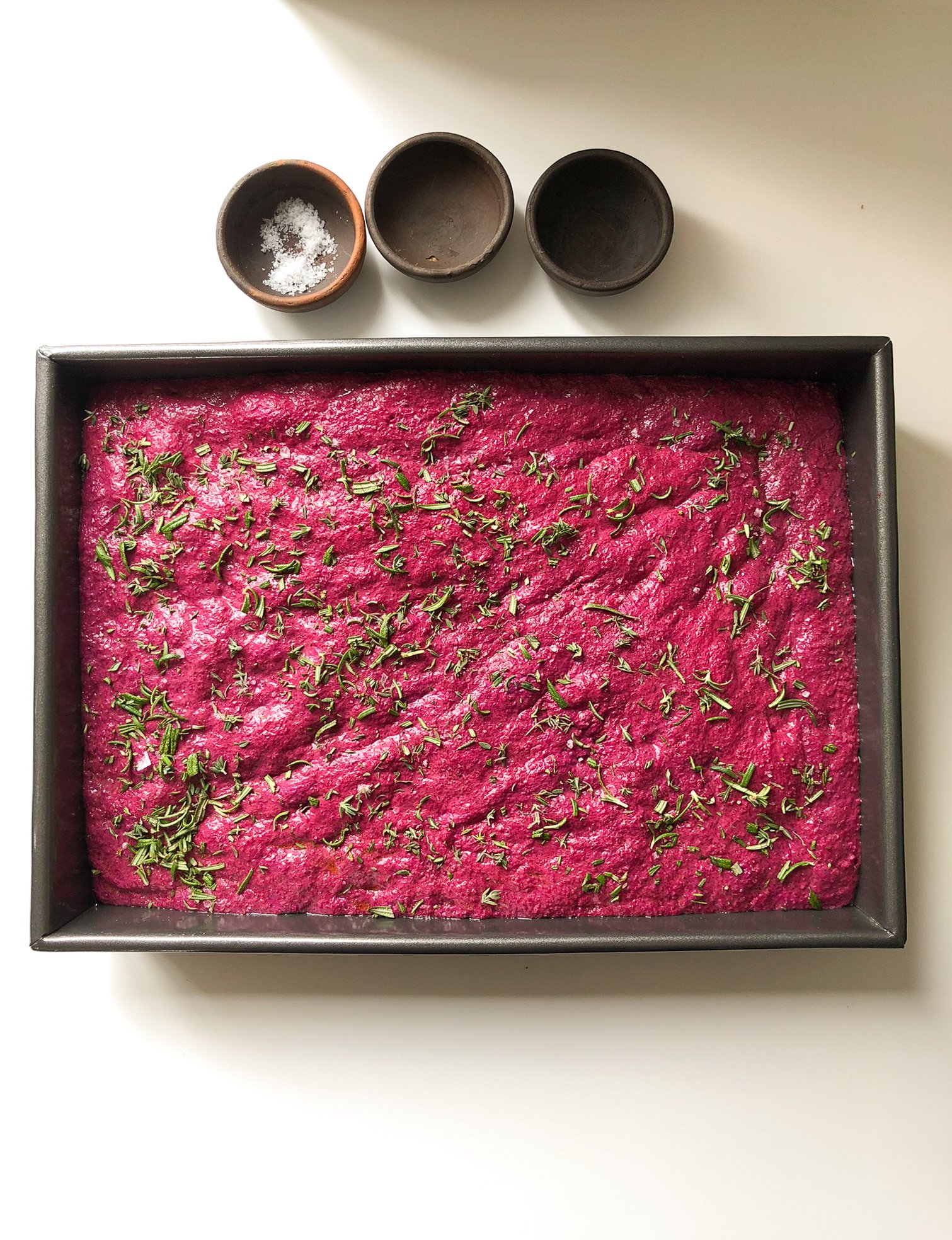
Nutrient-Packed Vegan Beetroot Focaccia
Vibrant, Nourishing & Delicious
This beetroot focaccia is soft, fluffy, and full of earthy, herby flavour—with a gorgeous natural pink hue. Light, airy, and packed with nutrients, it’s perfect for dipping, snacking, or pairing with soups and salads.
Prep
10 mins
Cook
25 mins
Total
4-12 h
Makes
500 gr
Ingredients:
2 medium Beetroots around 200-250gr
250 gr of strong wholemeal Wheat Flour
200 gr of Spelt Flour (see notes below)
50 gr of wholemeal Rye Flour
6 gr of dry Yeast
2 Tbsp of extra Virgin Olive oil
400ml of filtered Water (if using more beetroot reduce the water)
Toppings:
1/2 tsp of flaky sea Salt
1 Tbsp of Rosemary and/or Thyme
Garlic cloves (optional)

Instructions step by step:

Step 1 – Start by washing the Beetroots very well like me if not peeling them. You can peel them but I have a good blender so I’m leaving the skin because it has lots of nutrition and fibre. Cut them in small cubes and add them to a high speed blender with 150ml of the water. Blend to a smooth juice.

Step 2 – In a large bowl bring together all the Flours and dry Yeast. Mix them well and create a hole in the centre. Then pour the Beetroot juice in the middle with half of the remaining water and 1/2 Tbsp of Olive oil.

Step 3 – Start folding carefully with a silicone spoon from the centre to avoid splashing pink juice everywhere. Slowly add the remaining water as needed. If you are using more Beetroot you will need less water. Cover with a kitchen towel or lid and let it rest for 30 min.

Step 4 – After 30 mins, stretch and fold the dough 4 to 6 times by rotating the bowl between stretches. Let it rest for another 30 mins and repeat. This will help develop the gluten and elasticity but this step isn’t essential so you can skip it and proceed to the next step.

Step 5 – Spread the top of the dough with 1/2 Tbsp of Olive oil then cover with a lid or cling film. Let it prove in the fridge overnight or a maximum of 48 hours. Or prove at room temperature for 2-4 hours of until it doubles in size. This will depend on the temperature of your kitchen so in the summer it will rise faster and in the winter it may need help so I let it rest near a heater or heat source.

Step 6 – Pour 1/2 Tbsp of Olive oil in a 34x24cm oven tray. Spread with your hand to cover the bottom and sides. Add in the pink dough straight from the fridge or from your counter and help spread it with a spatula or your hands, You can also stretch and fold it a few times but not necessary. Let it rest and prove for another 1-2h. It will expand and double in size.

Step 7 – Pre- heat the oven at 200C fan. Top with the chopped Rosemary, Thyme leaves, flaky sea salt and 1/2 Tbsp of Olive oil.

Step 8 – Rub your hands lightly with Olive oil to coat then using all of your fingers, press straight down to create deep dimples. This feels immensely satisfying. If necessary, gently stretch the dough as you dimple to allow the dough to fill the pan. Let it rest for another 15 mins while the oven is preheating then bake for 25-30 mins.

Step 9 – Transfer the tray to the oven and bake for 15-20 minutes until the topping is crispy and brown. Allow to cool for 10-20 minutes to set then slice into it and serve.
About this recipe
I’ve got a bit of a love affair with bread. There’s something so comforting about it—it instantly takes me back to childhood, watching my grandmother knead dough in her cosy kitchen. Sourdough is my all-time favourite, but while my new starter’s still doing its thing, I used some dry yeast from the pantry to whip up this gorgeous, pink-hued, nutrient-packed focaccia.
You can make it in just 3–4 hours or let it prove overnight for deeper flavour. Both methods work beautifully.
There’s something therapeutic about baking bread—the rhythm of kneading, the transformation of dough, the smell as it bakes. I’ll never forget the first sourdough I made—part science, part intuition, and a whole lot of joy when I sliced into that crusty, airy loaf.
About these Ingredients:
Beetroots: The star of this focaccia is vibrant, earthy beetroot. It gives the bread its stunning colour and a boost of antioxidants and nutrients. Beetroot supports circulation and detoxification—so it’s as nourishing as it is pretty!
Smaller beets create a lighter, airier crumb, while larger ones add deeper flavour and richer colour. More beetroot means less water is needed, so if it’s your first time making bread, start with less water and adjust as needed. And don’t toss those beet greens—pop them into a soup or smoothie!
6 gr of dry Yeast: This is normally 1 individual sachet. Make sure it’s inside the use by date or if you aren’t sure, mix it with some of the water and wait until it bubbles and creates some foam then you know it’s active and ready to use.
Flours: I use a mix of strong wholewheat, spelt, and whole rye—all organic—for a rich, nutty flavour and slow-release energy. The fibre from the grains (and beetroot!) keeps you full and happy. You can swap in any flours you like, even gluten-free—I’ve made it with 500g of buckwheat flour, and it was delicious (just a bit less rise). The key is to stick to a total of 500g of flour, whatever combo you choose!


Rosemary and/or Thyme: Be generous—these herbs pair beautifully with beetroot. I usually add them by eye because I love their fragrant flavour. You can swap them for other herbs, but this combo is a winner in my book!
Extra Virgin Olive Oil: I usually avoid cooking with oil, but a little high-quality, cold-pressed olive oil goes a long way here. This recipe only needs 2 tablespoons total—just enough for the dough, proving, greasing the tray, and a light drizzle on top.
Flaky Sea Salt: I usually go light on salt, but for this focaccia, a sprinkle on top is a must. It won’t interfere with the yeast and gives you that lovely contrast—crunchy, salty crust on the outside, soft beetroot bread inside. I use Maldon, but any good flaky salt will do.
How to Enjoy It: This gorgeous pink-red focaccia is irresistible on its own—especially warm from the oven! I love dipping it in homemade hummus or pairing it with a delicious vegan cream cheese. It’s a showstopper for gatherings, perfect for BBQs, picnics, or packed lunches.

Nutrient-Packed Vegan Beetroot Focaccia
Marisa MarquesEquipment
- 1 High speed blender
- 1 Oven trey 34x22cm
Ingredients
- 2 medium Beetroots around 200-250gr
- 250 gr of strong wholemeal Wheat Flour
- 200 gr of Spelt Flour see notes below
- 50 gr of wholemeal Rye Flour
- 6 gr of dry Yeast
- 2 Tbsp of extra Virgin Olive oil
- 400 ml of filtered Water if using more beetroot reduce the water
Topping ingredients
- 1/2 tsp of flaky sea Salt
- 1 Tbsp of Rosemary and/or Thyme
- Garlic cloves optional
Instructions
- Start by washing the Beetroots very well like me if not peeling them. You can peel them but I have a good blender so I’m leaving the skin because it has lots of nutrition and fibre. Cut them in small cubes and add them to a high speed blender with 150ml of the water. Blend to a smooth juice.
- In a large bowl bring together all the Flours and dry Yeast. Mix them well and create a hole in the centre. Then pour the Beetroot juice in the middle with half of the remaining water and 1/2 Tbsp of Olive oil.
- Start folding carefully with a silicone spoon from the centre to avoid splashing pink juice everywhere. Slowly add the remaining water as needed. If you are using more Beetroot you will need less water. Cover with a kitchen towel or lid and let it rest for 30 min.
- After 30 mins, stretch and fold the dough 4 to 6 times by rotating the bowl between stretches. Let it rest for another 30 mins and repeat. This will help develop the gluten and elasticity but this step isn’t essential so you can skip it and proceed to the next step.
- Spread the top of the dough with 1/2 Tbsp of Olive oil then cover with a lid or cling film. Let it prove in the fridge overnight or a maximum of 48 hours. Or prove at room temperature for 2-4 hours of until it doubles in size. This will depend on the temperature of your kitchen so in the summer it will rise faster and in the winter it may need help so I let it rest near a heater or heat source.
- Pour 1/2 Tbsp of Olive oil in a 34x24cm oven tray. Spread with your hand to cover the bottom and sides. Add in the pink dough straight from the fridge or from your counter and help spread it with a spatula or your hands, You can also stretch and fold it a few times but not necessary. Let it rest and prove for another 1-2h. It will expand and double in size.
- Pre- heat the oven at 200C fan. Top with the chopped Rosemary, Thyme leaves, flaky sea salt and 1/2 Tbsp of Olive oil.
- Rub your hands lightly with Olive oil to coat then using all of your fingers, press straight down to create deep dimples. This feels immensely satisfying. If necessary, gently stretch the dough as you dimple to allow the dough to fill the pan. Let it rest for another 15 mins while the oven is preheating then bake for 25-30 mins.
- Transfer the tray to the oven and bake for 15-20 minutes until the topping is crispy and brown. Allow to cool for 10-20 minutes to set then slice into it and serve.
Notes
- protein pack |
- wholegrain |
- bread |
- vegan |
- beetroot
Did you make this recipe?
Please tag us on @fromplantswithlovekitchen
There are no reviews yet. Be the first one to write one.
